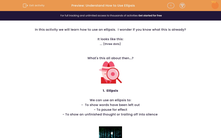In this activity, we will learn how to use an ellipsis. Do you know what this is already?
It looks like this:
...
What's this all about then...?
.png)
We can use an ellipsis to:
- Show words have been left out
- Pause for effect
- Show an unfinished thought or trailing off into silence

If we were writing about this forest and we wanted the reader to feel a bit scared, we might write:
As darkness fell, he listened carefully...nothing but silence.
Or
We were on our own now...
We could also use the ellipsis to show that we've left some words out. This might be because we only want to include the important words.
For example, if we were writing about a journey we had taken and the train had stopped at lots of different places, we would miss out some of them!
It wouldn't be effective writing to list all the towns and villages so we could write something like:
The train stopped at London Victoria, Clapham...and my home town of Croydon.

In this activity, we will be checking out how to use the ellipsis, as well as testing our knowledge of speech marks.
Here's a quick reminder of how to use speech marks, otherwise known as inverted commas.
1. The actual words being spoken need to be inside the speech marks (rather like the words in a speech bubble in a cartoon).
2. We start the speech inside the speech marks with a capital letter.
3. All speech must have a piece of punctuation at the end of it before closing the speech marks. This could be a question mark, exclamation mark or a comma.
4. There is usually a speech tag that goes with the speech saying who is speaking, eg. he whispered, Mrs Wilson shouted. This is not included inside the speech marks.
5. We always start a new line when a different person speaks.
Are you ready to have a go at the questions on both speech marks and ellipses?







